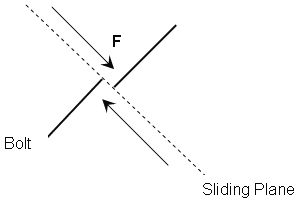Use Shear Capacity
The Shear Capacity of a bolt refers to the shear capacity perpendicular to the axis of the bolt (i.e., what shear force would be required to shear through the cross-section of the bolt), as shown in the figure below.

The Shear Capacity of a bolt can be considered in the analysis for any of the bolt types in RocSlope3 (except the Simple Bolt Force model).
To consider bolt shear strength:
- Select: Support > Define Bolt Properties

- Check off the Use Shear Capacity checkbox in the Define Bolt Properties dialog.
- Enter a value of Shear Capacity. The Shear Capacity is simply entered as a force.
Bolt Shear Capacity Implementation
If Use Shear Capacity is ON, it will be implemented in the analysis as described in the Bolt Implementation topic.
- The shear force will only be applied if a bolt intersects a shearing (sliding) plane of a block. This corresponds to bolt failure modes D, E or F.
- Shear force will NOT be applied if a bolt intersects a dilating plane (failure modes A, B or C).
- If shear force is applied, the direction of the applied shear force will always be exactly opposite to the sliding direction of the block.
Bolt Efficiency and Shear Capacity
Note that Use Bolt Orientation Efficiency is NOT used in conjunction with the Use Shear Capacity option. If you have selected the Use Shear Capacity option, and the bolt failure mode is D, E or F, so that the Bolt Shear Capacity is applied, the Bolt Efficiency DOES NOT multiply the shear strength. The Bolt Efficiency is only used as a factor for the tensile bolt capacity determined from the Bolt Force Diagram. It has no effect on the Bolt Shear Capacity.